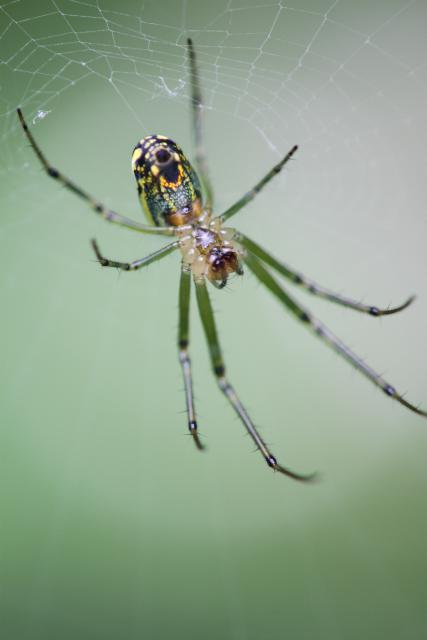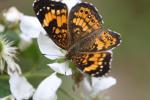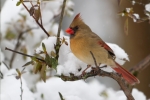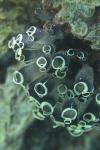macro
Kanawha State Forest Spider (part 2)
ktuli — Fri, 06/04/2010 - 22:13
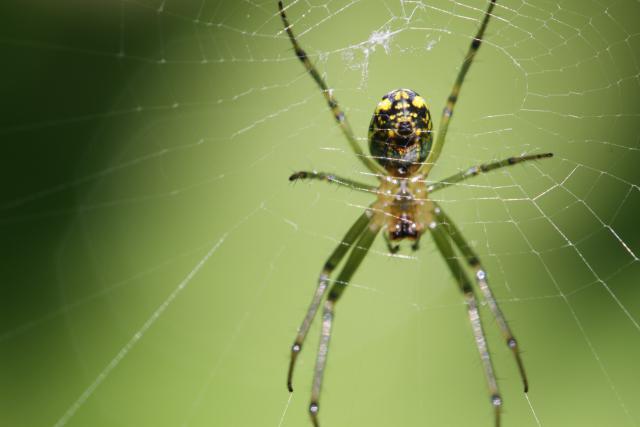
Technical Data: Canon EOS 7D, Tamron 180mm f/3.5 Di SP LD 1:1 Macro, 1/170 sec at f/7. ISO 200. Dolica AX620B100 tripod. No post production. Kanawha State Forest, Charleston, WV.
Resting Gorgone Checkerspot
ktuli — Wed, 06/02/2010 - 17:00
As promised, here's another photo of one of those Gorgone Checkerspot Butterflies. This little guy was willing to let me move in as close as my lens would allow (18.5 inches).
I moved around to a couple different angles and distances, but unfortunately was so focused on the butterfly and getting the images before he flew off that I only came up with this one image that I think works well.
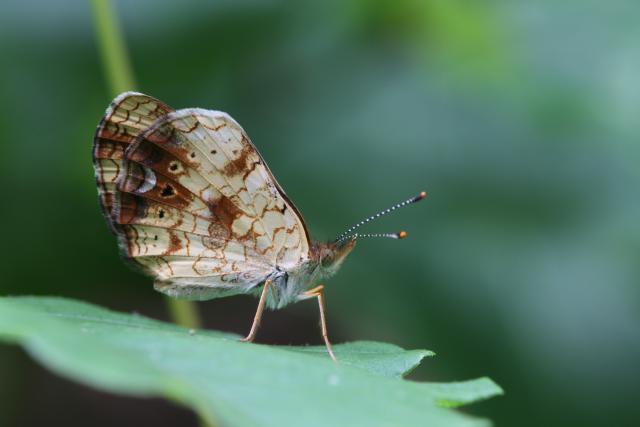
Technical Data: Canon EOS 7D, Tamron 180mm f/3.5 Di SP LD 1:1 Macro, 1/10 sec at f/9.1. ISO 200. Dolica AX620B100 tripod. No post production. Kanawha State Forest, Charleston, WV.
What Works: Focus is tack sharp with enough depth of field to keep most of the butterfly in focus (the very tips of its antennae are slightly blurred). The softly blurred background and framing with the offset butterfly is pleasing.
What Doesn't Work: The bright green grass stem in the background is a slight distraction, and if the antennae tips were in focus would be a bit nicer.
As I said, I took several other exposures of this guy, but none of them were just right. Everyone of them had some semi-major flaw with them that I was displeased with...

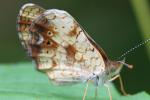
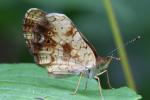
The image on the left has a weird convergence with the antenna tip and the eye of the butterfly. The center image shows my typical problem of cropping too closely in camera and cutting off key elements (antenna tip and feet in this case). While the third image has distracting background elements in a bad location right behind the butterfly's head.
That's why you take multiple exposures with a subject.
- Bill
Spider Strike Cropping
ktuli — Tue, 06/01/2010 - 20:23
So while we're on the subject of different framing, let's talk a bit about cropping to give yourself more framing options.
This is something I'm quite often guilty of not paying attention to, and unfortunately my error is usually in the sense that I crop too tightly in my original photograph (often cutting an element off) and not allowing myself room for software cropping later.
For this photo of a spider pouncing on its prey, I managed to leave myself room to crop...

Technical Data: Canon EOS 7D, Tamron 180mm f/3.5 Di SP LD 1:1 Macro, 1/21 sec at f/8. ISO 200. Dolica AX620B100 tripod. No post production. Kanawha State Forest, Charleston, WV.
After reviewing at home on the computer, I felt the image lacked impact with the spider being small within the frame. So I fired up Photoshop to see what cropping possibilities there were...

I am not entirely sure how I feel about the stem of grass in the vertical crop, but I didn't want to remove it and modify the image much for this discussion. However, the grass works just fine in the horizontal crop.
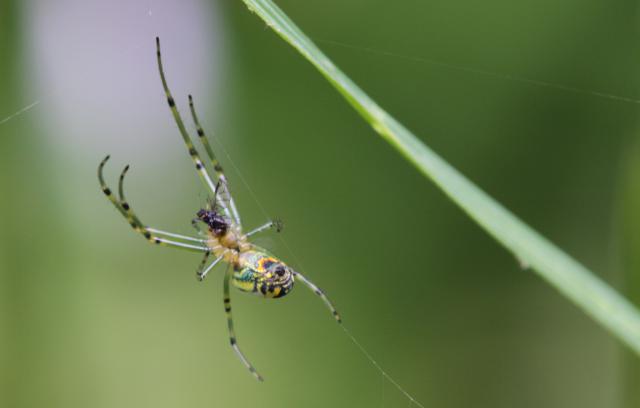
In general, I'm not really one to do much post production editing to my photos. I don't know if it is a perfectionism kind of thing, or just a dislike for edited photos (though one can argue whether simple cropping is much in the way of editing).
However, if I continue to find examples like this that open multiple possibilities from a single exposure, I may start turning that opinion around.
- Bill
PS: For a better view of this spider, check out my current favorite spider photo
Poll: Break from the Bugs
ktuli — Mon, 05/31/2010 - 17:31
So I guess we can take slight break from all the bugs (though if you've missed them, scroll down and check them out).
I took these two photos specifically with the thought in mind to try multiple framing options for a subject.
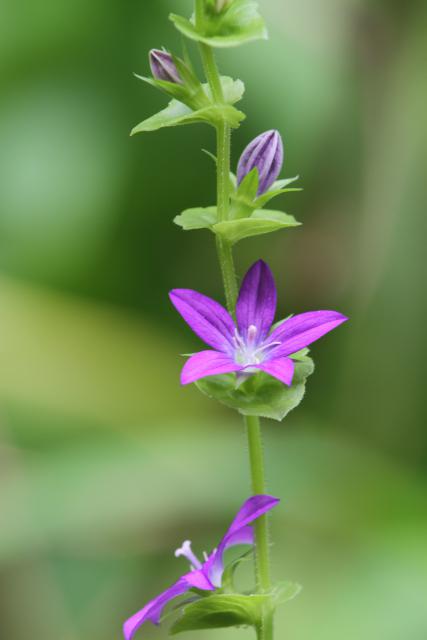
Close Crop
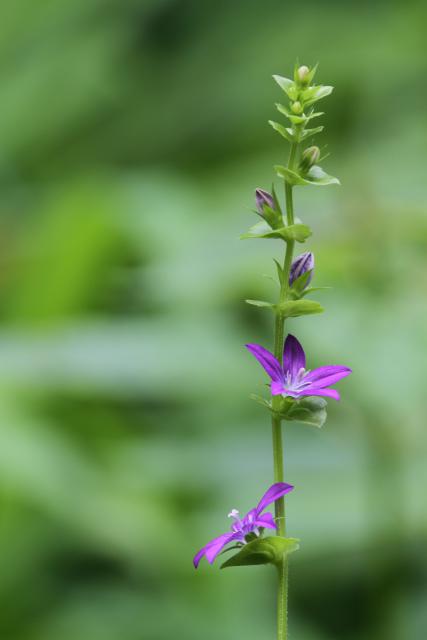
Wider Crop
Technical Data: Canon EOS 7D, Tamron 180mm f/3.5 Di SP LD 1:1 Macro, 1/32 and 1/50 sec at f/8. ISO 200. Dolica AX620B100 tripod. No post production. Kanawha State Forest, Charleston, WV.
Unfortunately I was using a prime lens, so I actually had to move the whole camera, so these aren't necessarily identical framing, but I still like both. Vote for your favorite and drop me a comment to let me know why.
- Bill
Simple White & Brown Moth
ktuli — Sun, 05/30/2010 - 12:50
I am resting on the sofa today after getting up really early for 3.5 hours of hockey before it got too ridiculously hot, so I figured I should make another post. I continued scanning through my photos from the Kanawha State Forest in WV. So far, this set has produced posts about a Gorgone Checkerspot Butterfly, my current favorite unidentified green spider, and Apheloria virginiensis millipedes.
Today, I stumbled across this photo that I have overlooked several times already and really don't remember taking...
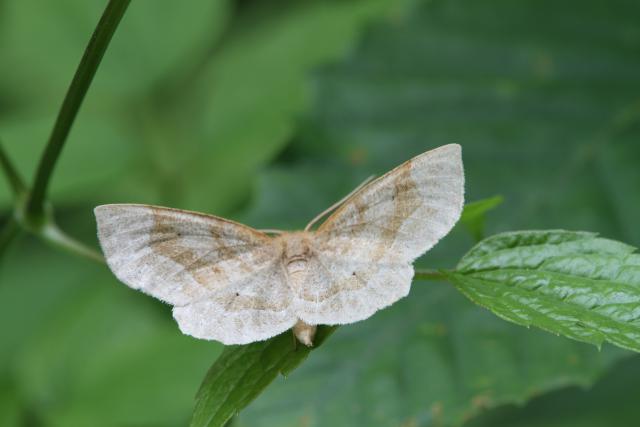
Technical Data: Canon EOS 7D, Tamron 180mm f/3.5 Di SP LD 1:1 Macro, 1/25 sec at f/11.3. ISO 200. Dolica AX620B100 tripod. No post production. Kanawha State Forest, Charleston, WV.
Why This Photo: Honestly. this is basically a one-off photo. I have one other shot of this moth, but I either didn't get much of a chance to or didn't want to spend much time with this subject.
What Works: The biggest thing that struck me with this photo is its simplicity. There is basically just the main subject and nothing else to distract you from it. Yet the photo isn't flat - the blurred background still holds enough to keep (at least my) interest.
What Doesn't Work: Focus is sharp, but it is either slightly forward of where it should be, or I needed a slightly wider depth of field. If you check the full-size version, the head and antennae of the moth are blurred. Kind of minor, but it sure would make a better photo. Also, it would have been nice if I could have gotten the face of the moth in the photo - but sometimes that's easier said than done.
Oftentimes, that one-off photo turns out to be a really nice photo. And many times, simpler is better.
And then there's that whole luck factor... ;)
- Bill
Black and Gold Millipede (Apheloria virginiensis)
ktuli — Thu, 05/27/2010 - 19:46
First, if you have not yet seen the previous posts from this series, you should definitely check them out! The first post has a butterfly shot, and the second post in the series has my current favorite spider photo! Some really awesome stuff you don't want to miss.
I've been wanting to find a millipede to photograph for some time now. As we started our first photo hike through the Kanawha State Forest I quickly saw one of these black and gold millipedes - I have yet to find a common name for them, and doubt everyone will want me to call them Apheloria virginiensis repeatedly. Though I could... a couple years of owning and operating a tropical fish store and hatchery has gotten me pretty fluent with scientific names.

After spotting one, it became quite easy to find many more - they were almost everywhere. I spent multiple attempts trying to capture a good image of one of these guys to little avail. I quickly had to reassess my impression of millipedes as slow and cumbersome critters. These little buggers could sure run - it was pretty difficult to get good focus.
But I tried...
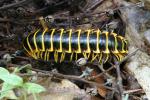
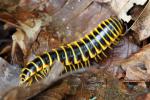
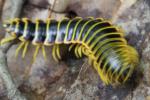
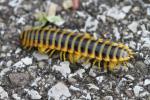
... and tried and tried and tried some more.
Which is why I'm not going to really critique any of these shots. I basically feel at best all I managed was either a record shot or worse - a poorly focused record shot. I spent so much effort trying to track these guys as they ran along the ground, and whenever they did stop I couldn't get them at a good angle to produce a nice photograph (and trying to adjust anything around them - like moving a stick or leaf - caused them to start running again).
With their bright markings, we were pretty cautious about disturbing them too much and didn't want to handle them at all, and it turns out that was a very good idea since they are reported to secrete a cyanide compound as a defense, that while not necessarily deadly would have caused a lot of discomfort and possible injury. In general, remember that bright markings on insects and other animals can often indicate that it is poisonous.
So that will be the lesson for today's photos - have a healthy respect for your subject. Whether for your own safety or for the better well-being of the subject, keep that respect at the forefront of your mind - ahead of even getting that prized image. Especially if you are not familiar with your subject, such as this case, remember to give your subject its space and only observe, and you'll be fine. You might have to go back later to try for another shot later, but there are much worse possibilities.
- Bill
Kanawha State Forest Spider (part 1)
ktuli — Wed, 05/26/2010 - 20:56
If you haven't read the first post from our Kanawha State Forest trip, check it out here.
This is the first of several shots of the same species of spider (I haven't been able to identify it yet) I took while wandering around the Kanawha State Forest outside Charleston, WV.
We saw this spider on our first day there, and I got several shots I liked, but still went back for more on Sunday. I found the same three spiders in the same locations and took a bunch more shots. Specifically one of the things I went back for was a vertically oriented photograph, and this is probably my favorite one from the set.
Technical Data: Canon EOS 7D, Tamron 180mm f/3.5 Di SP LD 1:1 Macro, 1/130 sec at f/3.5. ISO 200. Dolica AX620B100 tripod. No post production. Kanawha State Forest, Charleston, WV.
Why This Photo: I really wanted a vertical shot of this spider, so I specifically went back to capture an image like this.
What Works: Focus is pretty sharp. I like the diagonal orientation of the spider within this vertical shot. And though I didn't specifically try for it, the background produces a nice frame around the spider within the frame of the shot, and very faintly keeps the web in the shot towards the bottom while also making the spider appear to be floating in mid-air.
What Doesn't Work: Unfortunately, to achieve the focus I did, I had to use a wide aperture which causes the spider's legs to not be in focus while the body is in focus. And the one tip of the leg on the right side of the frame just barely breaks the right of the edge of the image.
I have some more photos of these spiders to share later, but drop me a comment and let me know what you think of this one.
Thanks for stopping by.
- Bill
Gorgone Checkerspot Butterfly
ktuli — Tue, 05/25/2010 - 20:51
Anya and I took a trip down to Charleston, WV this past weekend, and so I spent two days taking photographs in Kanawha State Forest. The first day we spent roughly two hours walking just a 0.25 mile trail.
We saw tons of things to photograph because I had our Tamron 180mm Macro lens set on the camera. We spent the entire time looking for tiny critters to photograph - things from butterflies, to frogs, to millipedes, and spiders... tiny flowers, mushrooms, and even some strange wild dwarf strawberries.
Anya really is a great spotter. I love being out on photo excursions with her. She finds a subject for me, then wanders ahead to find another while I set up shop and take some photos. She really helps with my patience to move slower through an area and look at things much more closely - definitely helpful when you're out for macro shots.
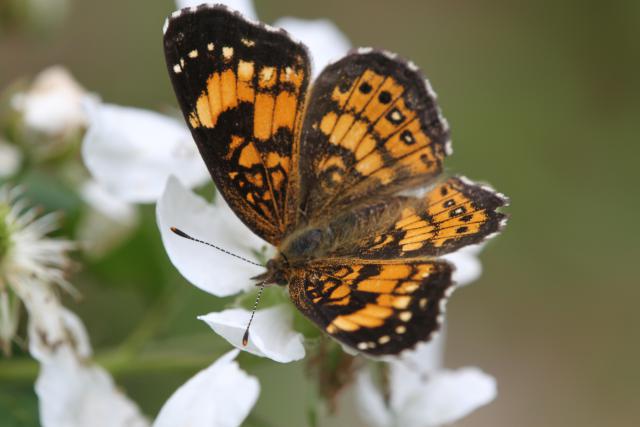
Technical Details: Canon EOS 7D, Tamron 180mm f/3.5 Di SP LD 1:1 Macro, 1/100 sec at f/7. ISO 200. Dolica AX620B100 tripod. No post production. Kanawha State Forest, Charleston, WV.
Why This Photo: We had just hopped out of the truck, and gotten started. There were butterflies all over the place, so what better subject to get started with. Butterflies are incredibly elusive, but so rewarding when you manage to get a good crisp shot.
What Works: I like the soft background of this photo, with enough detail to not be bland and boring. The framing is nice - I had another shot that was slightly crisper in focus, but the edge of the wing got clipped off - this shot has the entire butterfly in the shot, and nicely offset to keep things interesting.
What Doesn't Work: The focus is just the slightest bit soft on the eyes of the butterfly (but you have to look at the full size version to really notice). Additionally, I failed to hit that perfect time when the both wings were parallel to the camera's sensor to produce both wings in focus - this isn't as huge of a deal in my opinion, but a shot with both wings crisp would be worth so much more. And finally, I wish the butterfly had been oriented in a more upright position as opposed to this downward facing direction - but beggars can't be choosers (at least not yet).
Researching more on this butterfly to find the species (Chlosyne gorgone) showed that they are only reported to live in that specific county in WV where the Kanawha State Forest is. They live plenty of other places in the country, but I just happened to get lucky with this one in that area.
They by far were the most abundant butterflies in the park, and were definitely the most cooperative to photograph. I'll have another shot of one that I shot later that day that literally let me move around it and inch closer and closer as if it could care less. I'll share that photo later, I promise.
What do you think of this shot? Maybe compare it to this one to the right which is the one I mentioned that the wing tip got cropped out (darn constantly moving subjects combined with a gentle breeze!).
Leave me a comment and give me a little critique.
And stay tuned as I have many more photos to share from this outing.
- Bill
Honorable Mention: Emerald Boa
ktuli — Thu, 05/13/2010 - 20:58
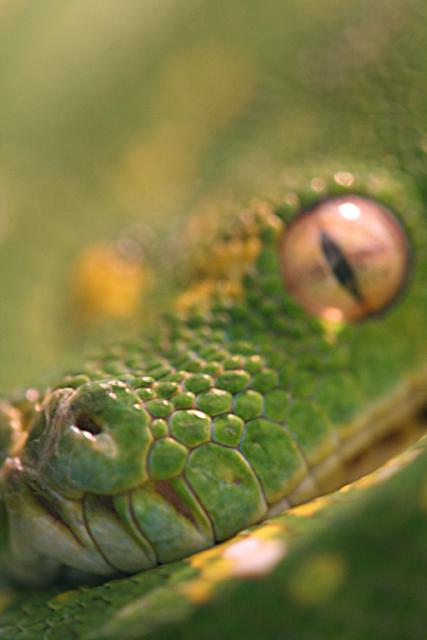 This photo recently received honorable mention in one of the Photographic Section's digital competition and qualified for year-end judging.
This photo recently received honorable mention in one of the Photographic Section's digital competition and qualified for year-end judging.
Technical Data: Canon EOS Digital Rebel XT, Tamron 180mm f/3.5 Di SP LD 1:1 Macro, 1/2 sec at f/3.5. ISO 400. Sharpened in Photoshop Elements 8.0. Columbus Zoo and Aquarium, Columbus, OH.
Why This Photo: I've always liked emerald boas and other arboreal snakes. The posture of these snakes as they bask on their coils on three branches is always interesting to me. Finally, I intentially focused on the heat sensory pits instead of on the eyes for a different look at things.
What Works: The sharp focus on the heat pits gives a new look at things, and the softened eyes still keep your attention. The catch-lights on the eyes and scales are a nice touch too.
What Doesn't Work: The section of the body in the bottom right that is out of focus is somewhat distracting, but the framing of the shot prevents it from being cropped out. Also, there appears to be a tiny bit of a double image on the eye - probably from the long exposure.
What do you think? Leave me a comment and let me know...
- Bill
PS: I continue to slowly make progress on those site improvements I talked about. Hopefully I'll have something to demo soon.
Crab Spider (part 3)
ktuli — Mon, 04/19/2010 - 20:26
So we're closing in on the end of the available photos from this crab spider. Towards the end of the shoot, this little guy definitely let me know he was getting tired of me.
That is definitely something you need to be conscientious of when working with any kind of wildlife photography. Your subject will definitely let you know when you need to back off. Ideally, you want to be done with your photos well before that time comes - both for the health of your subject as well as for the natural behavior to be captured in your images.
It is a little tougher to identify those warning signals with small insects and spiders. This is definitely one, though.
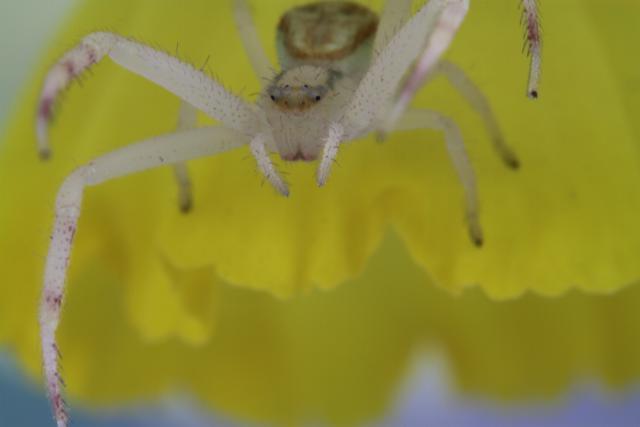
Technical Data: Canon EOS 7D, Tamron 180mm f/3.5 Di SP LD 1:1 Macro with Kenko Teleplus PRO 300 "DG" AF 2x Teleconverter for effective 360mm with 68mm in extension tubes. 1/2 sec at f/9.1 and exposure compensation +1/3 stop. ISO 200. No post production.
Why This Photo: I was just working the subject as much as I could before having to pack it in. At this point, almost any motion caused him to rear up and posture aggressively (earlier in the shoot, it took dramatic motions or very loud noises like my dog barking). At this point, he was charging to the edge of the flower and waving his front limbs around like crazy. I had him framed and set for what I thought would be a great shot, and as I pressed the shutter release and started the timer, he waves his limbs around again, and I just had to get whatever posture he ended up in when the timer ended.
What Works: Focus is sharp, and I like the overall exposure. I like how the edge of the flower was visible in this shot - so many of the shots in this set were so zoomed in that it wasn't always apparent that this was on a flower.
What Doesn't Work: The original framing had all parts of the spider inside the shot, but after he decided to flail about wildly, that wasn't the case for the final shot. I could have not framed the original shot so tightly, but then I would be sacrificing some of the magnification.
One other thing I was going for with this shot was to capture the nice greenish color on the abdomen of the spider. It really was very beautiful. You can catch a hint of it here, but unfortunately, I don't think I did such a good job of capturing that. I didn't manage to get it in any of the photos in this set.
What do you think?
- Bill

